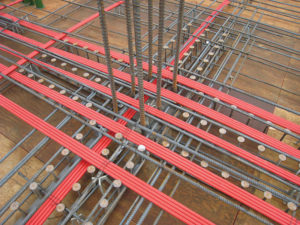When major building codes are not in agreement on specific structural members, confusion and uncertainty are propagated among design engineers. In this case, the industry may need to start a conversation with code authorities for clarification.
Three issues specific to the design of post-tensioned members are currently treated differently by the American Concrete Institute’s Building Code Requirements for Structural Concrete and Commentary, ACI-318 (2014), and Europe’s Design of Concrete Structures – Part 1-1 General rules and rules for buildings, European Code EC2 (2004). For any designer working globally, these two code documents define the design of post-tensioned members. Also, the go-to literature for the design and analysis of PT members is contradictory. The three sources considered here are the Post-Tensioning Institute’s Design Manual (2000) and two design treatise, one by E. G. Nawy and one by the author of this article. (See the references at the end of this article for specifics.)
The discrepancies are found with regard to:
1) The value of the bending moment at which a section must be reinforced to be safe at the initiation of cracking. This is typically referred to as the “cracking moment” of the section, Mcr.
2) Whether the provision for safety at the initiation of cracking due to the bending moment applies to members reinforced with bonded, unbonded, or both bonded and unbonded post-tensioning tendons.
3) Which structural systems the provision applies to – beams, one-way slabs, two-way slabs, or all structural systems.
Given the increasing popularity of post-tensioned buildings worldwide, it seems logical that an effort should be made to standardize these design criteria.
Value of the Cracking Moment
The cracking moment of a post-tensioned member is of interest to structural engineers for two reasons. First, depending on the application, cracking may need to be limited for serviceability concerns. In these cases, the objective is to avoid the “initiation” of cracking. The second reason is the “safety” of the member; in these cases, the aim is to ensure that the section at the location where the crack forms has adequate strength to avoid failure, irrespective of the cause of the cracking. The serviceability objective is achieved by controlling the conditions that lead to cracking. The focus of the two major building codes, ACI 318 and the European Code (EC2), is about the safety of the member if cracking occurs.
The following sections explain both the safety and serviceability objectives and include applicable expressions for the calculation of the cracking moment.
Service Condition
Cracking at a section begins when the extreme fiber tensile stress of the member reaches the modulus of rupture, fr, of the section’s material. ACI 318 recommends that fr for concrete be calculated as:
fr = 7.5[pmath]sqrt{f prime_c}[/pmath] (Equation 1)
When considering the condition that leads to cracking at a given section in a post-tensioned member, such as section X-X in the member shown in Figure 1a, it is recognized that the post-tensioning tendons at the section provide a stress distribution as shown in Figure 1b. P/A is the precompression from the post-tensioning force P, acting on the section with cross-sectional area A, and fb is the extreme fiber stress from the post-tensioning moment.
Where, fb = Mpt/S (Equation 2)
Mpt is the moment from post-tensioning and S is the section modulus. Mpt is also referred to as the balanced moment since the post-tensioning is typically designed to balance a certain percentage of the dead load. The magnitude of Mpt depends on the geometry and support conditions of the member, as well as the tendon profile and post-tensioning force. It includes both the primary moment (Pe) and the hyperstatic (secondary) moment from the reactions at the supports as a result of the post-tensioning.
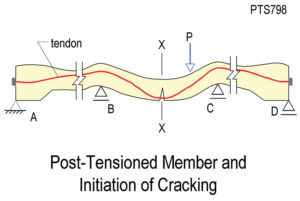
Figure 1a. Partial elevation; continuous member reinforced with post-tensioning forces leading to cracking at section X-X depend on the overall geometry of the entire structure, features of its post-tensioning tendons and the applied load (PTS798).
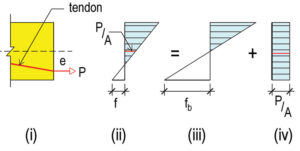
Figure 1b. Distribution of stress from post-tensioning on a section. P/A is the average precompression; fb is the extreme fiber stress from post-tensioning moment, Mpt. P is the post-tensioning force and e is the eccentricity of the force with respect to the section’s centroid.
For cracks to form at section X-X, the applied forces on the member must exceed the combined extreme fiber compressive stresses from the prestressing, fb and P/A, to the extent there is a tensile stress fr. Hence the required moment at the section at the initiation of cracking, calculated from principles of static equilibrium will be:
M = (fr + [pmath]P/A[/pmath]) S + Mpt (Equation 3)
Safety Condition
The second area of interest relative to the cracking moment is the “safety” of the member. Unlike serviceability which is concerned with the member before cracking, the safety objective requires consideration of the relevant section after cracking. In the case of cracking having occurred, the objective is to ensure that the section at the location where the crack forms has adequate strength to avoid failure, irrespective of the cause of the cracking.
Although the focus of ACI 318 and European Code EC2 is on the serviceability factors, both codes include text on the safety requirement after cracking; however, neither provides details on the required calculations. Also, the topic is addressed differently in the publications above.
The safety of a section after the initiation of cracking is achieved by providing adequate reinforcement. The reinforcement should develop a moment not less than the moment that initiated cracking. At cracking, the distribution of stresses over the section is as shown in Figure 1b (ii), irrespective of the overall characteristics of the member, such as the number of spans or the loads on the member. The moment for this distribution, Mcr is:
Mcr = (fr + P/A) S (Equation 4)
The difference between the numerical values of the two conditions, service, and safety, is that the service condition includes the post-tensioning moment Mpt, with the hyperstatic (also referred to as secondary) moments as an integral part of it. The applicable moment Mcr for the safety condition includes only the precompression (P/A) from prestressing.
In summary, to avoid failure of a section at the initiation of cracking, the reinforcement in the section must develop a moment capacity Mn not less than the moment Mcr that initiated the crack. Factors of safety must be applied both to reduce Mn and increase Mcr. K, the factor of safety for Mcr depends on the building code; ACI 318 recommends a safety factor of 1.2.
φMn ≥ KMcr (Equation 5)
Where, φ is the strength reduction factor.
A possible source of discrepancy between the calculations for the two conditions could be the interpretation of the wording used in ACI 318 -14, where the requirement is expressed in terms of “cracking load,” as opposed to cracking moment. The European Code EC2 states the requirement in terms of the “cracking moment.”
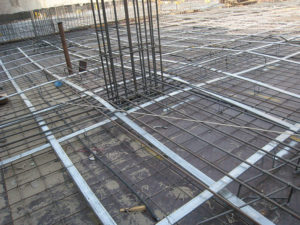
Figure 2. Two-way slab construction with unbonded and bonded post-tensioning tendons. (a – top) Slab construction with unbonded tendons. Neither ACI nor EC2 requires a strength check at the initiation of cracking (P998). (b – bottom) Slab construction with bonded tendons ACI requires a strength check at the initiation of cracking. EC2 does not (P999).
Evaluation of the Cracking Moment
ACI 318-14 requires the evaluation of the cracking moment for slabs reinforced with bonded tendons (Figure 2b) – both one-way and two-way systems, using a factor of safety K=1.2. Evaluation of the cracking moment is not required for slabs reinforced with unbonded tendons based on the argument that, because there is no bond between the strands and the concrete, a sudden local increase in strain at the crack location will be distributed over a length of strand crossing the crack, thus avoiding a local rise in strand strain and the strand’s rupture (Figure 2a).
The European Code EC2 also requires an evaluation of the cracking moment, but only for beams reinforced with unbonded tendons. Per EC2, a safety factor of 1.15 is required. ACI 318-14 requires the same with a factor of 1.2 for beams reinforced with bonded tendons. Clearly, there is a disagreement as to whether to apply a safety factor to unbonded or bonded tendons or do designers assume that the safety factor applies to both conditions?
Note that the distribution of moment in beam stems and one-way slabs is essentially uniform in the transverse direction to the span. Initiation of cracking at one point will result in the extension of the crack over the entire width of the beam stem or slab width. For two-way, column-supported slabs, however, due to the non-uniform distribution of stress (Figure 3), loss of capacity due to cracking at the location of maximum moment demand will result in a redistribution of the moment to regions where capacity is available, thus providing greater resilience for two-way slab systems. The moment redistribution property of the two-way system is the likely reason why in the European code it is not required to check its safety at the initiation of cracking.
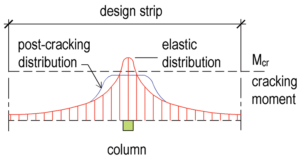
Figure 3. Plan – Tributary (design strip) of a column support in two-way slab construction. Distribution of moment at the face of column before and after cracking. Loss of capacity due to the cracking spreads the cracking and mobilizes the slab’s strength beyond the column (PTS761).
Literature Discrepancies
ACI 318-14 applies only to two-way slabs reinforced with bonded post-tensioning:
8.6.2.2.2 – For slabs with bonded prestressed reinforcement, total quantity of As and Aps shall be adequate to develop a factored load at least 1.2 times the cracking load calculated on the basis of fr defined in 19.2.3.
(Note: the value of fr as defined in section 19.2.3, is given in Equation 1 above.)
EC2 (European Code) applies only to beams. EN 1992-1-1:2004, Section 9.2.1-1(4) states:
For members prestressed with permanently unbonded tendons or with external prestressing cables, it should be verified that the ultimate bending capacity is larger than the flexural cracking moment. A capacity 1.15 times the cracking moment is sufficient.
The PTI Design Manual Fifth Edition, Section 5.3.3.5, explains the application of the ACI 318’s statement for strength calculation of members after cracking as follows:
… the requirement is intended to prevent abrupt flexural failure immediately after cracking… This requirement is commonly satisfied, when required, at each section as follows:
φMn = 1.2(7.5[pmath]sqrt{f prime_c}[/pmath]S + [pmath]SF/A[/pmath] + Mbal) (3-1)
This is the same as expression Equation 3 above, with the safety factor (1.2) recommended by ACI 318 added, and Mbal used to represent the post-tensioning moment Mpt, and F is the post-tensioning force.
PTI’s expression (3-1) is also used frequently in the literature for the safety of section after cracking.
Conclusions
In addition to the differences in the literature on the calculation of the demand forces for the safety of a section at the initiation of cracking, the requirements as to when the cracking moment needs to be evaluated to verify the safety are different in ACI 318 and EC2. Observation of thousands of buildings designed according to each of these codes, and the apparent lack of reported failure resulting from these provisions, could imply that the requirement may not be critical in the design of post-tensioned members. But, if they are not of critical concern, why are they detailed in the codes? However, in light of the increasing popularity of buildings constructed with post-tensioning, the safety requirements of post-tensioned members at the initiation of cracking should be revisited and clarified.▪
References
Aalami, B. O., (2014), Post-Tensioned Buildings, Design and Construction, ADAPT Corporation, Redwood City, California, www.PT-Structures.com.
ACI 318, (2014), Building Code Requirements for Structural Concrete and Commentary, American Concrete Institute, Farmington, MI.
European Code EC2, (2004), Eurocode 2: Design of Concrete Structures – Part 1-1 General rules and rules for buildings, European Standard EN 1992-1-1:2004.
Nawy, E. G., (1997), Prestressed Concrete, A Fundamental Approach, Prentice Hall, International, New Jersey, 3rd ed., 938 pp. 1997.

